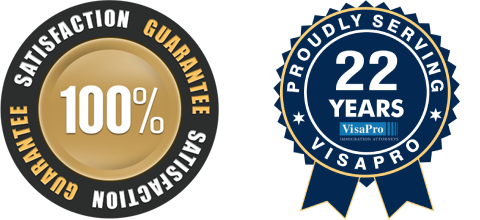Introduction
U.S. has long been considered as the ‘Land of Opportunity’. Foreign businesses consider opening a company in USA after achieving success in their home country.
For starting a business in USA as a foreign company or non-resident, and move key personnel to the U.S., New Office L1 Visa is a great option.
‘New Office’ L1 Visa
For non-us citizens starting a business in USA, the L1 intra-company transfer visa allows to start operations in the U.S., move key personnel who are managers, executives and specialized knowledge employees. L1 visa allows qualified executives and managers a faster path to secure Green Card under the EB-1C category.
L1 visa to start a business in the US as a non-citizen is widely used by citizens of countries that are not on the E-1 or E-2 treaty list, such as China and India, among many others.
New Office L1 Visa – What Is It?
The regulations define New Office as an organization which has been doing business in the United States through a parent, branch, affiliate, or subsidiary for less than one year.
New Office L1 Visa – Who Qualifies?
In order to qualify for an L1 visa where a new office is involved, the petitioner must submit evidence that:
- Sufficient physical premises to house the new office have been secured;
- Beneficiary meets the one-year continuous employment requirement;
- Petitioner has the financial ability to commence doing business in the United States.
- The intended U.S. operation will support an executive, or managerial position within one year, If the beneficiary is coming to the United States as a manager or executive.
My Case Scenario
Pietr
Helmut is the President of a German company that manufactures and distributes natural medicines. He knows that with the growing interest in the US for natural medicines there is great growth potential. To tap that potential he feels that the company must have a subsidiary in the US to import their products and to develop a marketing network. He taps a young executive in the company, Pietr, that he knows got his MBA in the US to head up the new venture.
Where should Pietr begin?
New Office L1 Visa – 6 Essential Tips To Keep In Mind
1. Writing A Business Plan
Although not as complex and thorough as one that you would submit to investors, a business plan has become required for successful New Office L1 petition.
The Business Plan offers the petitioner an opportunity to succinctly lay out details about the new venture, a personnel plan and plans to hire and forward-looking projections.
Business plans for this purpose typically range in the area of 8-12 pages and are more what you would consider executive summaries than fully featured business plans.
DID YOU KNOW?
It is important to include the following in your business plan:1. Personnel plan for the new office in the U.S. detailing how many employees the newly formed U.S. Company plans to hire in the first year and, preferably, over the next four to five years.
2. Financial projections (i.e. revenues, costs, and others), setting out the company’s short-term and long-term goals.
My Case Scenario
Pietr
Pietr begins his research and presents his plan to the company board of directors, including an extensive business plan. The business plan shows that the US subsidiary should be profitable within the first 6 months and with aggressive marketing should be have gross annual revenue of $2 million by the third year.
2. Obtaining An Office Lease
The 21st century has brought us the capacity to work fully from home or to utilize innovative office solutions such as virtual offices and other types of temporary office space. USCIS, however, has still not embraced this concept and continues to require a brick and mortar physical office space.
For a New Office L1 Visa
a.The office space should be large enough to support the company and its planned growth in the first year;
b.The lease should be signed for a minimum of 6 months;
c.The newly formed U.S. Company should be listed as the tenant on the lease.

3. Company Registration
One of the most important steps in setting up a new office in the U.S. is to form a business entity. Most times it makes the most business sense to incorporate in the state where you plan to conduct majority of your business, or where your company is located. However, this is not always the case.
Two of most common types are a Limited Liability Company and Corporation. The formation process in most of the states is straightforward and generally requires the filing of articles of incorporation with the Secretary of State in the state where you wish to register your company.
IMPORTANT
The decision on where you should register your new business enterprise and what type of an entity you should choose depends on your company’s long-term and short-term goals.The choice of which type of business entity you choose could have an impact on your tax liability and is best made with the consultation of a trained professional such as a business attorney or, at the least, a certified public accountant.
4. Organizational Charts
Often the underestimated parts of the New Office L1 petition package, the organizational charts are actually a very important piece of the New Office L1 puzzle.
Every company should submit two organizational charts or organograms that detail the employee hierarchy and structure- one for the home country office and the other for actual and/or proposed company structure in the U.S. They are especially important when the company seeks to send an executive or a manager to the U.S. on an L1A visa.
When it comes to organization charts, creativity is highly discouraged and the best organization charts are those that provide a clear hierarchical view of the company’s leadership from top to bottom.
When transferring persons from higher company ranks, the role of the organization chart is to show that the concerned person is an executive or a manager and to present a clear view to USCIS about the company’s personnel expansion plans in the new U.S. office.
TIP
The idea behind the organization chart as used in the immigration context is to show the personnel reporting structure in your home company and the U.S. entity.One common problem in making organization charts is that companies often insist on including departments or divisions on the chart. This should be avoided, because it may provide a confusing picture to USCIS. The various departments or divisions should be represented by its personnel on the chart and not as separate entities by the name of the division.
My Case Scenario
Pietr
Pietr is given the go ahead, a large budget and heads for the US to establish the subsidiary and lease office space. He has identified the New York City area because of its proximity to US pharmaceutical companies and the ease of receiving shipments from the company in Germany.
After the initial work is completed Pietr is granted an L1A and moves to the US to start developing the marketing network and growing the company.
5. Hiring Personnel
The New Office L1 will initially be approved for one year. The company will need to hire staff before they can file for their one year extension in order to justify the presence of the L1A Executive or Manager or L1B Specialized Knowledge individual. The reasons include:
a.to show that the company has been growing during the first year becoming a viable business and
b.to show that the office continues to require a manager or an executive, in cases a manager or executive was sent to open the new office in the US as an L1A.
DID YOU KNOW?
1. The question that many companies ask when they are told about the hiring requirement is: how many people do we have to hire?
2. The answer is not straightforward because the regulations do not set out concrete numbers. Instead, the company should hire as many individuals as is needed to operate the venture in the U.S. successfully and meet its financial goals.
6. Maximizing Chances of Getting The First Year Extension
Many companies looking to expand try to minimize the costs of expansion until they obtain new contracts or the business looks promising. USCIS however requires that within the first few months the U.S. office show a growth in personnel.
In order to maximize your chances of getting the first year extension petition approved, we always recommend our clients to hire some U.S. citizens or Green Card holders to fill the required positions. Although many companies may want to send workers to their new U.S. office from the home office, the reason why we recommend hiring some local talent is so the company can get a healthy balance of local U.S. workers and foreign workers on the U.S. company payroll and organization chart.
Taking this more conservative approach in the beginning will inevitably prove to be a wise decision when the New Office L1 is submitted for extension and later on when the company needs to send more key personnel to the U.S.
DID YOU KNOW?
In determining whether to grant an extension after the first year, USCIS considers several factors such as the number of employees, growth in revenues, attainment of significant clientele, and other similar elements indicating that the entity has been actively engaged in business activities.
Conclusion
The L1 intra-company transfer visa category offers many perks, but is also complex to navigate effectively and without incurring liability. Small to mid-size companies need to submit well-prepared applications and any ambiguities as to the company’s or the beneficiary’s credentials will be closely scrutinized by USCIS.
This article was intended as an introduction to some of the aspects associated with applying for a New Office L1, but it is not fully exhaustive. The issues are many and the complexity of this visa is often underestimated by those that do not have extensive experience in the area of immigration law.
In case you are deliberating over setting up a new business venture in the U.S. or wish to enter the U.S. to invest in, manage or work for an existing business enterprise, contact VisaPro Law Firm today for a FREE Visa Assessment.
We’ll analyze your situation and recommend a cost-effective strategy based on our attorneys’ near 100% success rate.
What VisaPro Customers Are Saying
I have known VisaPro since 2006 and we have work together on many instances which required intense brainstorming and VisaPro's ideas and suggestions have always been par excellence. An opportunity to interact and work with VisaPro is a true privilege."

 Mitesh Bohra, Co-founder & President, InfoBeans, Inc
Mitesh Bohra, Co-founder & President, InfoBeans, Inc



